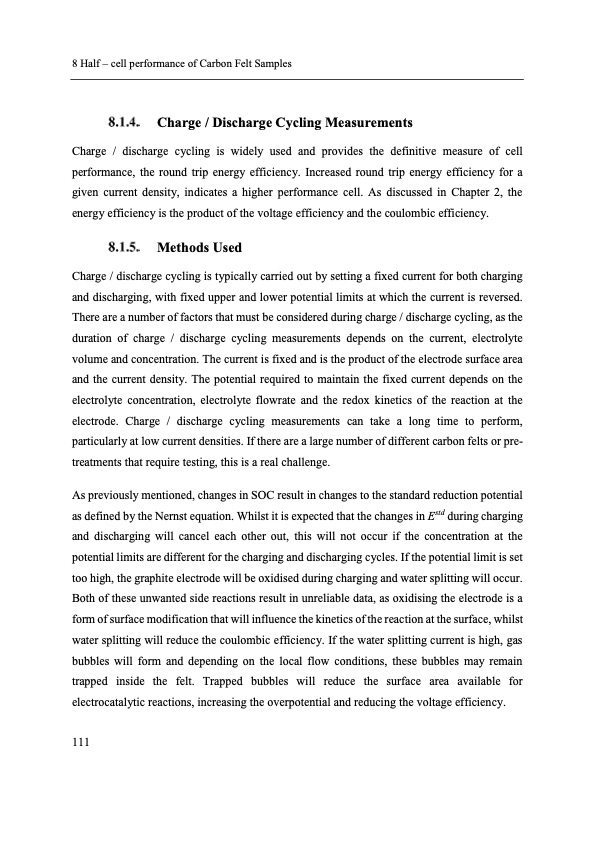
PDF Publication Title:
Text from PDF Page: 123
8 Half – cell performance of Carbon Felt Samples Charge / Discharge Cycling Measurements Charge / discharge cycling is widely used and provides the definitive measure of cell performance, the round trip energy efficiency. Increased round trip energy efficiency for a given current density, indicates a higher performance cell. As discussed in Chapter 2, the energy efficiency is the product of the voltage efficiency and the coulombic efficiency. Methods Used Charge / discharge cycling is typically carried out by setting a fixed current for both charging and discharging, with fixed upper and lower potential limits at which the current is reversed. There are a number of factors that must be considered during charge / discharge cycling, as the duration of charge / discharge cycling measurements depends on the current, electrolyte volume and concentration. The current is fixed and is the product of the electrode surface area and the current density. The potential required to maintain the fixed current depends on the electrolyte concentration, electrolyte flowrate and the redox kinetics of the reaction at the electrode. Charge / discharge cycling measurements can take a long time to perform, particularly at low current densities. If there are a large number of different carbon felts or pre- treatments that require testing, this is a real challenge. As previously mentioned, changes in SOC result in changes to the standard reduction potential as defined by the Nernst equation. Whilst it is expected that the changes in Estd during charging and discharging will cancel each other out, this will not occur if the concentration at the potential limits are different for the charging and discharging cycles. If the potential limit is set too high, the graphite electrode will be oxidised during charging and water splitting will occur. Both of these unwanted side reactions result in unreliable data, as oxidising the electrode is a form of surface modification that will influence the kinetics of the reaction at the surface, whilst water splitting will reduce the coulombic efficiency. If the water splitting current is high, gas bubbles will form and depending on the local flow conditions, these bubbles may remain trapped inside the felt. Trapped bubbles will reduce the surface area available for electrocatalytic reactions, increasing the overpotential and reducing the voltage efficiency. 111PDF Image | Electron Transfer Kinetics in Redox Flow Batteries

PDF Search Title:
Electron Transfer Kinetics in Redox Flow BatteriesOriginal File Name Searched:
electron-transfer-flow-batteries-thesis.pdfDIY PDF Search: Google It | Yahoo | Bing
Salgenx Redox Flow Battery Technology: Salt water flow battery technology with low cost and great energy density that can be used for power storage and thermal storage. Let us de-risk your production using our license. Our aqueous flow battery is less cost than Tesla Megapack and available faster. Redox flow battery. No membrane needed like with Vanadium, or Bromine. Salgenx flow battery
| CONTACT TEL: 608-238-6001 Email: greg@salgenx.com | RSS | AMP |